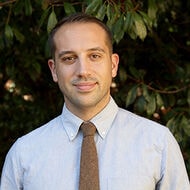
When High School is Flight School, Students Soar
The sky’s all clear for these Arizona high school students who take their lessons at 4,000 feet.
When students at South Mountain High School tell people they spend four mornings each week flying airplanes, few believe them. South Mountain is one of the oldest schools in Phoenix. It's taken a long time to recover from the tumultuous reputation it acquired in the '90s and 2000s, and for the plunge in enrollment to reverse. Assistant Principal Nick Oviedo (Phoenix ’09) half-jokes “the magnet school needed to regain its magnetism.”
But this year South Mountain, where virtually all students get free or reduced-price lunch, had to cap freshman enrollment. Oviedo believes one reason is the allure of the school’s aerospace and engineering program, through which students can take about $20,000 worth of flight school lessons as part of their free public education and become licensed pilots.
South Mountain also offers magnet academies in law, visual and performing arts, and communications, aiming for high student enthusiasm and deep engagement. Oviedo sees a future in which all students are taking classes that could prepare them for specific careers or just give them “an excellent and unique education.”
Early on a December morning, the students of South Mountain’s flight school were preparing for an unusual kind of school day, one they would spend with their heads (and the rest of their bodies) in the clouds.
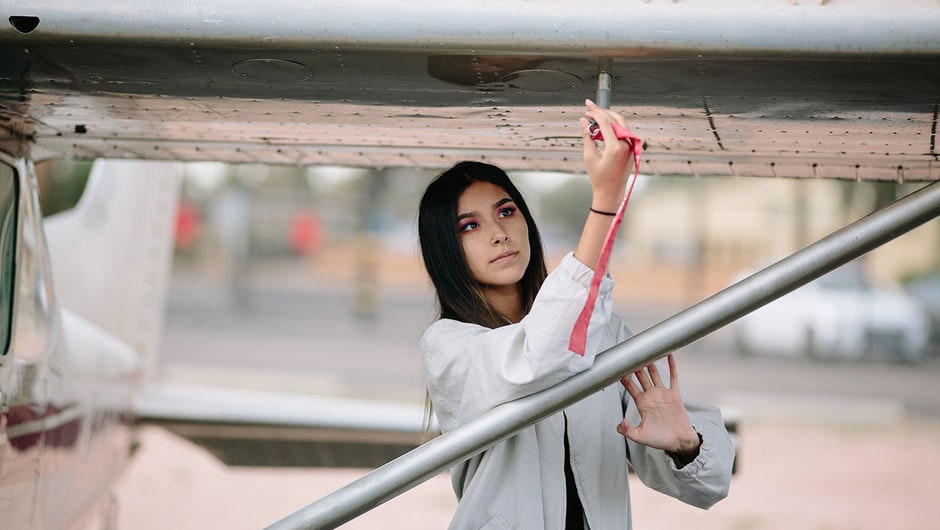
Senior Itati Giron (above) goes to bed at 8 p.m. so she’ll be alert and focused the next day while she’s flying a two-door, single-engine plane. She wakes at 4 a.m. to get to school by 6:30. One by one, the six seniors in Itati’s class arrive at school, in the dark, at their meeting spot in the parking lot. They laugh and joke as they climb into a van that drives them across Phoenix to the city of Mesa, about 45 minutes away.
Arizona calls itself the sunset state, but it’s the sunrise that now paints the sky above the desert with gold, pink, and flames of red. Inside the van, the students are engrossed in each other’s company. Pablo Mendiaz has a new joke he learned from watching YouTube videos of Norm Macdonald. J.J. Obasi is singing again, this time reimagining “You’re the One That I Want” from Grease as a song about the military (“You better enlist!”) J.J. is known for singing ridiculous songs. Last week it was “Hot Chocolate” from the movie The Polar Express.
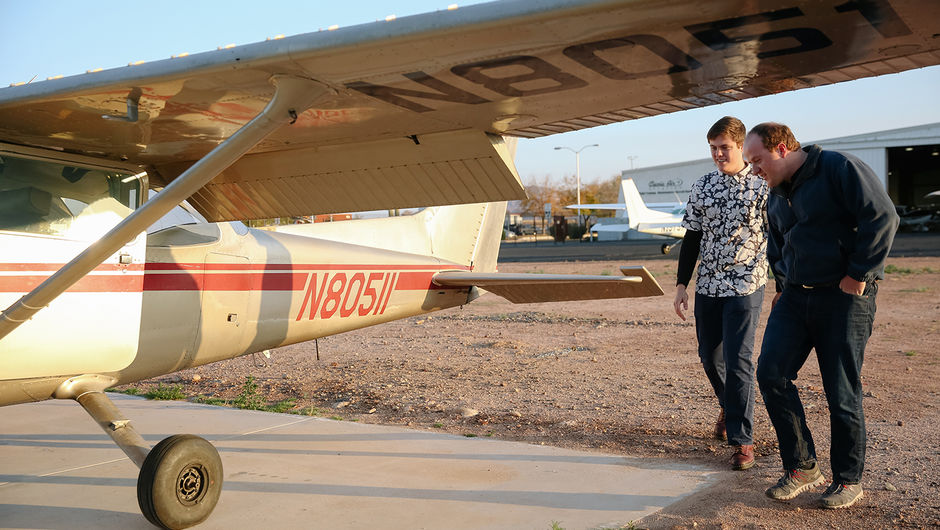
When the seven students arrive at Falcon Field Airport, they file into Classic Air Aviation flight school. In partner teams, they grab flight bags packed with aviation headsets and flight logs. They meet to go over the day’s lesson and flight plan in a classroom adorned with clocks made of dashboard instruments. Half the students will stay here to review material they’ll present at the end of the morning’s lesson. The others, including Caleb Ready (above in the floral shirt) and an instructor, head outside to the airfield to begin their pre-flight checklists. The silly kids from the van are gone. At flight school, they’re all business.

Today Caleb flies his plane (with his flight school instructor sitting at a second set of controls) while his partner J.J. reviews airspace maps and procedures in the classroom. The students each have a nickname for the day of the week that best suits their personality. J.J. and Caleb are “Sunday” and “Monday,” for J.J.’s air of purpose and Caleb’s often-unfortunate luck. “I’ll be flying and everything will be going perfectly, and then right as I’m landing I’ll get hit with a crosswind that knocks the plane offcenter. And we’ll all just shrug and say, ‘That’s so Monday!’” explains Caleb.
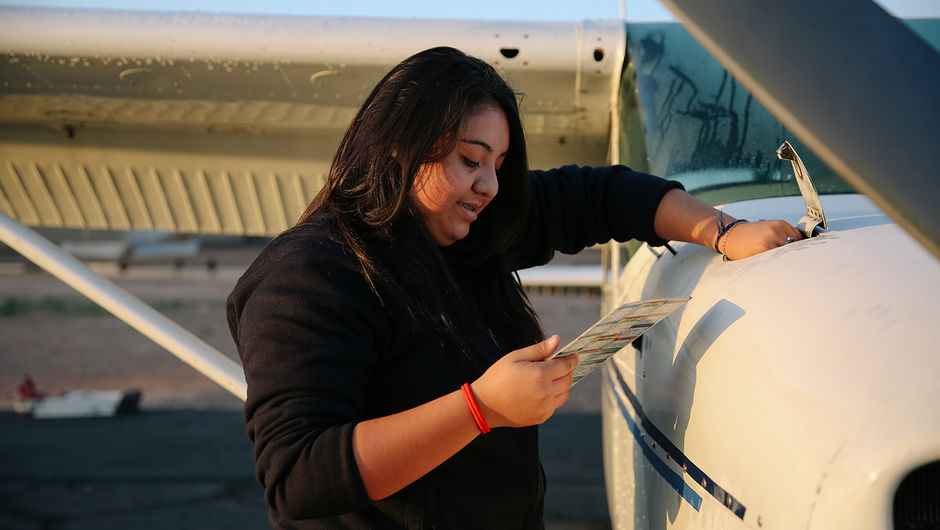
Ana Pozos (“Wednesday,” pictured above) and Maria Ramirez (“Thursday”) stay back to review fuel mixtures, maneuvering speeds, and emergency procedures. In order to get admitted to flight school, students had to memorize the answers to 827 questions that might appear on a 60-question aviation test they’d have to pass. But in order to qualify to take that test, students first had to pass five consecutive practice tests, each with a score of 90 percent or higher (they refer to this as getting their 5-90s, as in five consecutive 90 percents). Ana passed the most tests. Caleb, on the other hand, scored 90 percent on four consecutive tests before scoring an 89 on his fifth test and having to start over—three times. (“That’s so Monday!”)
Before Pablo ("Saturday") climbs into his plane, he does a few practice flights in the simulator. His usual Cessna 127M is in the hangar for routine inspection and maintenance, so today he’ll be flying the Cherokee Arrow, which is faster and has more sensitive controls. All the students agree that the Arrow is an upgrade, and they grumble with congenial jealousy at Pablo’s luck. “The Arrow is fast,” Pablo admits after he returns from his first flight. “You all should have broken your planes sooner.”
All of these students plan to receive their pilot’s licenses by the time they graduate in June. Most will be licensed to fly before they can drive. For Pablo, flight school has already changed his life. He had never been on a plane, any plane, before he stepped into the cockpit of the single-engine Cessna. In fact, none of his family had ever been on a plane. Now, he’d like to be a bush pilot after he graduates.
Caleb’s dream plane is a Wilga 2000, a rare Polish bush plane, built for taking off and landing on extremely short runways (“Like, in 50 feet!”). J.J. has significantly more taste for speed and would love to fly an F-16. His idol is Chuck Yeager, the Air Force officer and flying ace who broke the sound barrier in the Bell X-1—“the Glamorous Glennis, named after his wife,” J.J. reminds us.
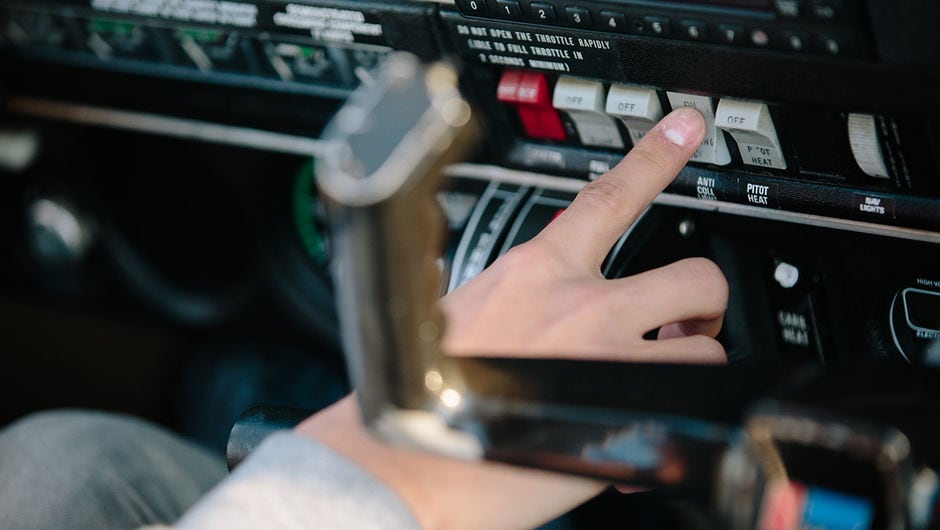
Unlike Itati and the others, Anna and Maria don’t plan to use their pilot’s licenses professionally. For them, the chance to learn to fly while in high school was just too exciting to pass up. They heard about the aerospace program while in middle school and knew they wanted to enroll at South Mountain even if that meant long commutes to school. They started in the program as freshmen and watched as every year the number of students who’d stick with the rigorous study dropped off. “Last year in ground school, there were 25 of us, but not everyone got recommended for flight school,” Caleb explains.

Itati, with her senior classmates (above) discovered the program late. She was a junior when she transferred to South Mountain from her neighborhood high school in Alhambra. “Alhambra was five minutes away from my house, my whole family went there, but I didn’t feel like there was anything special. I needed something exciting to help me move forward, college- and career-wise,” she said.
Nick Oviedo remembers how excited he was to give Itati a South Mountain tour. She said she wanted to work for NASA and that she’d convinced her parents to let her apply. While Itati hopes that her high school aviation studies will track her towards admittance to Embry-Riddle Aeronautical University and her big goal—working at NASA—Oviedo sees her school journey from a different angle. To him, it’s proof that big comprehensive high schools can offer first-rate, engaging learning experiences. Itati agrees: “I feel really proud of myself after every lesson, because every day I do something new that I’ve never done before.”
Sign up to receive articles like this in your inbox!
Thanks for signing up!
Content is loading...


